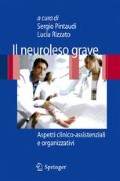Riassunto
La ventilazione artificiale meccanica costituisce il trattamento di prima scelta in presenza sia di gravi patologie a carico dell’apparato respiratorio, sia in patologie extrapolmonari, che determinano la compromissione della respirazione autonoma e quindi una condizione di elevata instabilità clinica che, se non corretta tempestivamente, comporterebbe la morte del soggetto. Qualunque sia l’eziopatogenesi della compromissione della funzione respiratoria autonoma, la condizione che si determina è sempre costituita dall’incapacità/impossibilità per il paziente di svolgere/mantenere un lavoro respiratorio adeguato al fabbisogno di ossigeno metabolico, per cui si rende necessario un supporto esterno invasivo alla funzione respiratoria. Tale supporto è costituito dalla Ventilazione Meccanica Artificiale (VAM) che, mediante apposite apparecchiature (ventilatori), vicaria la respirazione autonoma in soggetti in cui essa risulta alterata, compromessa o artificialmente inibita. Le indicazioni generali della ventilazione artificiale invasiva sono determinate dallo squilibrio tra lavoro respiratorio autonomo, efficacia dello scambio di gas a livello della membrana alveolo-capillare, del trasporto e dello scambio di ossigeno a livello tessutale, nonché della rimozione dell’anidride carbonica (Tabella 9.1) [1].
Access this chapter
Tax calculation will be finalised at checkout
Purchases are for personal use only
Preview
Unable to display preview. Download preview PDF.
Bibliografia
Burns SM (2005) Mechanical Ventilation of Patients with Acute Respiratory Distress Syndrome and Patients Requiring weaning. Crit Care Nurs 25(4):14–24
Chatburn RL (2007) Classification of Ventilator Modes: Updates and Proposal for Implementation. Respiratory Care 52(3):301–323
Romano E (2003) Il Malato Critico. Principi e pratica della Terapia Intensiva. UTET, Torino
Grinnan DC, Truwit JD (2005) Clinical review: Respiratory mechanics in spontaneous and assisted ventilation. Critical Care 9:472–484
AACN (2004) Consensus Conference on Sedation Assessment. Crit Care Nurse 24(2):33–40
Frawley PM, Habashi NM (2001) Airway Pressure Release Ventilation: Theory and Practice. AACN Clinical Issues 12(2):234–246
Mercat A, Richard JCM, Vielle B et al (2008) Positive End Expiratory Pressure Setting in Adults with Acute Lung Injury and Acute Respiratory Distress Syndrome. JAMA 299(6):646–655
Ashurst S (1997) Nursing care of the mechanically ventilated patient in ITU. British Journal of Nursing 6:475–485
Couchman BA, Wetzig SM, Coyer FM et al (2007) Nursing care of the mechanically ventilated patient: what does the evidnce say? Part One. Intensive Critical Care Nursing 23:4–14
Coyer FM, Wheeler M, Wetzig SM et al (2007) Nursing care of the mechanically ventilated patient: what does the evidence say? Part Two. Intensive Critical Care Nursing 23:4–14
Lindgren VA, Ames NJ (2005) Caring for patients on mechanical ventilation: what research indicates is best practice. Am J Nurs 105(5):50–60
Urden LD, Stacy KM, Lough ME et al (2007) Thelan’s Critical Care Nursing. 5a ed Mosby Inc, St Louis
Murphy BA, Durbin CG (2005) Using Ventilator and Cardiovascular Graphics in the patient who is Hemodinamically Unstable. Resp Care 50(2): 262–274
MacIntyre NR, Epstein SK, Carson S et al (2005) Management of Patients Requiring Prolonged Mechanical Ventilation. National Association Medical Direction of Respiratory Care (NAMDRC) Consensus Conference. Chest 128:3937–3954
Stiller K (2000) Physiotherapy in intensive care: towards evidence-based practice. Chest 118(6):1801–1813
Urden L, Stacy K, Lough M (2006) Critical Care Nursing, diagnosis and Management 5a ed Mosby, Elsevier
Author information
Authors and Affiliations
Editor information
Editors and Affiliations
Rights and permissions
Copyright information
© 2010 Springer-Verlag Italia
About this chapter
Cite this chapter
Rapisarda, G. (2010). Ventilazione artificiale meccanica invasiva. In: Pintaudi, S., Rizzato, L. (eds) Il neuroleso grave. Springer, Milano. https://doi.org/10.1007/978-88-470-1460-2_9
Download citation
DOI: https://doi.org/10.1007/978-88-470-1460-2_9
Publisher Name: Springer, Milano
Print ISBN: 978-88-470-1459-6
Online ISBN: 978-88-470-1460-2
eBook Packages: MedicineMedicine (R0)

